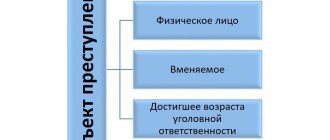A crime is a socially dangerous act committed by a subject under the Criminal Code of the Russian Federation. The law provides for criminal liability for such an offense. The Code determines for what acts the subjects who commit them are punished.
To investigate a crime, it is important to determine its nature - completed or unfinished. However, what is important here is not just the presence of all the necessary signs. A person’s idea of the final result of an action plays a significant role: whether the socially dangerous acts that were intended were realized and whether the desired consequences occurred.
Based on this, it is worth turning to the classification of the crime depending on the content of the objective side. That is, in this way it is possible to highlight the moment of the end of criminal actions. So, there are formal, material, truncated elements of the crime.
Each of these types has its own significance in criminal law, so it is necessary to consider all options in detail. Many scientists are inclined to think that there are only two main types - formal and material elements of a crime. They claim that the truncated one is a variation of the first and will not exist as an independent one.
Formal elements of the crime: how to determine?
A crime with a formal composition is understood as a type of offense that provides that it will be completed from the moment when a socially dangerous act is committed. That is, the necessary characteristics do not include causation and consequences.
So, the object of such a crime does not differ from the objects of material or truncated elements. That is, these are the same social relations protected by criminal law. Liability is provided for causing specific harm or creating a threat of causing it.
As for the subject, it also does not differ from the other elements of the crime. This is the same individual who commits an offense at the age at which criminal liability begins in accordance with the Criminal Code of the Russian Federation.
There are also other signs of a formal crime. These include the objective and subjective side. It is in these categories that the main differences between this composition and the rest are contained.
The meaning of the signs of a crime
When absolutely all the signs of a crime (composition) are identified in the committed act, then it can be considered socially dangerous. In addition, the presence of a crime is a direct reason for bringing the person who committed the crime to criminal liability.
In this case, it is thanks to the composition that one of the many socially dangerous acts presented in the Special Part of the Criminal Code of the Russian Federation will be identified. It should be noted that in the absence of at least one of the elements of the composition, the act cannot be recognized as a crime.
Objective and subjective side of the formal corpus delicti
The objective side is determined by the external manifestations of a socially dangerous attack. The formal and truncated elements of the crime differ in that in the first it is the commission of criminal acts (or inaction) that is punishable. The occurrence of certain criminal consequences is not required. It turns out that the criminal performs all the actions that he wanted, which means that the crime is considered completed without causing any harm dangerous to the public.
Practice has shown that a larger percentage of formal crimes are committed with direct intent. It is generally accepted that the commission of such an offense cannot be careless, because it requires a specific subjective attitude to the upcoming consequences. If they do not occur, the guilty person will not be held accountable in accordance with the Criminal Code. In such a situation, the punishment will be determined by administrative law.
The significance of characteristic signs of a violation
If the illegality has identified all the signs of a crime required for consideration, if the elements of the violation have been identified, it is recognized as dangerous to society and the perpetrator is punished.
The presence of a crime is a direct and indisputable reason for bringing a person to the police and bringing him to criminal responsibility. Thanks to the identified composition of the recorded violation, it can be identified as quite dangerous, designated in a special part of the modern criminal and penal code of the Russian Federation.
If a recorded violation lacks at least one of the elements of the general criminal offense, it cannot be considered punishable.
Formal elements of the crime: examples
In order to more clearly consider this type of crime, it is necessary to rely on specific examples.
So, having analyzed Art. 139 of the Criminal Code, we can say that the violation of the inviolability of the home, according to the above, is completed from the moment when illegal entry into the premises directly occurred, committed against the will of the person who lives in it. In this case, the legislator did not include a socially dangerous criminal consequence as a mandatory feature in the disposition of the article. Although it comes here as moral damage.
Also, the formal corpus delicti extends to high treason, extortion, rape, and taking a bribe.
Mixing elements of crime
There are cases when the legislator in one composition provides for liability as a completed crime only if two conditions are met: a socially dangerous act has been committed and consequences have occurred.
For example, let's take Art. 258 of the Criminal Code. This article provides for liability for illegal hunting if it is committed: causing great damage; using a mechanical vehicle or aircraft, explosives, gases or other methods for the mass destruction of animals and birds; regarding animals and birds that are prohibited by law from hunting; in a natural area protected by law, in an emergency or environmental disaster zone. Such a composition by design is called the material and formal composition of the crime.
Crimes with material content
This is a crime in which the crime is completed from the moment when socially dangerous consequences occur. That is, consequences are a mandatory condition, without which the offense committed will be interpreted differently.
Crimes with material elements include, for example, murder, theft, bodily harm of varying degrees, fraud, and more.
Crimes with a truncated composition
This is a crime in which the offense is considered completed from the moment of preliminary criminal activity, that is, at the stage of preparation or attempt. The definition immediately makes it clear why the formal and truncated elements of the crime are combined into one. Because in both cases there are no consequences as a mandatory feature.
Crimes with formal elements include, for example, encroachment on the life of a statesman or public figure, robbery, the formation of a criminal organization, banditry, and others.
Composition of the crime: concept, meaning and types
The basic composition contains a typical description of a certain type of crime without indicating mitigating or aggravating circumstances. As a rule, it is described in part one of article of the Special Part of the Criminal Code of the Russian Federation.
Compositions with mitigating circumstances include a circumstance that significantly reduces the danger of a crime, and with aggravating circumstances - a circumstance that significantly increases the danger of a crime. These compounds are also called qualified. They are, as a rule, indicated in the second and subsequent parts of the article or in a separate article of the Special Part of the Criminal Code of the Russian Federation. For example, in Part 1 of Art. 105 of the Criminal Code of the Russian Federation contains the basis for murder, in its part 2 - qualified types with aggravating circumstances, in Art. 106-108 of the Criminal Code of the Russian Federation - qualified types with mitigating circumstances.
In simple offenses, the legislator indicates all the signs of a crime one-dimensionally (for example, murder encroaches on one object, is committed by one act, entails one consequence, has one form of guilt - Part 1 of Article 105 of the Criminal Code of the Russian Federation).
In complex compositions, at least one of its signs is indicated in a non-uniform manner (for example, robbery encroaches on two objects - Article 162 of the Criminal Code of the Russian Federation; intentional infliction of grievous bodily harm, resulting in the death of the victim through negligence, is characterized by a combination of two forms of guilt - Part 4 of Article 111 of the Criminal Code RF). A type of complex composition is a composition with alternatively specified characteristics. In them, some signs are described alternatively. Such compositions may contain several objects of a crime (nuclear materials or radioactive substances - Article 221 of the Criminal Code of the Russian Federation), several actions (purchase, storage, transportation, production or processing - Article 228 of the Criminal Code of the Russian Federation), several consequences (serious harm to health or causing a large damage - Article 267 of the Criminal Code of the Russian Federation), several ways of committing a crime (deception or abuse of trust - Article 159 of the Criminal Code of the Russian Federation). To recognize an act as a crime, at least one of the alternatively specified signs is sufficient.
Material crimes are recognized Consequently, the objective side of crimes with this composition is characterized by three mandatory features:
- act;
- socially dangerous consequences;
- causal connection between them.
Material offenses include murder, bodily harm, all forms (except robbery) and types of theft, many environmental, transport and other crimes.
Formal crimes are considered to be those whose objective side contains one mandatory feature - a socially dangerous act.
Such crimes are rape, slander, insult, knowingly reporting an act of terrorism, receiving and giving bribes, falsifying evidence, etc.
In the literature, a type of formal composition is identified - truncated, the distinctive feature of which is that the legislator connects the moment of completion of crimes with such a composition not with the complete execution of the criminal act, but with the commission of only part of these actions. Outwardly, they look like an attempt or even preparation to commit a crime, but the legislator transfers the moment of completion of a crime with such elements to the stages characterizing preliminary criminal activity. For example, robbery in the law is described as an attack with the purpose of theft, i.e. as actions directly aimed at stealing someone else’s property - Art. 162 of the Criminal Code of the Russian Federation (in this case, the moment of completion of the crime is transferred to the stage of attempted crime); banditry is characterized by the legislator as the creation of a stable armed group (in this case, the moment of the end of the crime is transferred to the stage of preparation for committing the crime).
The elements of real (specific) danger are characterized by an act that created the threat of the consequences specified in the law. Thus, they differ from material elements in that responsibility for such crimes is not associated with the actual infliction of consequences, and from formal ones in that the law specifically indicates possible consequences. For example, a terrorist act (Article 205) or violation of the rules for handling environmentally hazardous substances and waste is criminally punishable if it created a threat of causing significant harm to health or the environment (Criminal Code of the Russian Federation).
Common and distinctive features
Along the way, we found out that the formal and material elements of a crime are types that have common objects and subjects, but the objective and subjective sides are completely different. They have different mandatory characteristics of these sides, so it is quite difficult to confuse these two types.
As for the truncated composition, it also has common features with the formal and material. They are united by social relations protected by law and the individual committing the crime. However, the objective side of this offense has common features with only one. This has been mentioned several times above - the formal corpus delicti does not define the consequences as a mandatory feature, as in the truncated one.
What's different? For the formal one, it is enough to commit criminal acts, but for the truncated one, preliminary criminal activity is important.
Elements of criminal composition
To determine the formal or material composition of a violation of the law, it is necessary to know the basic elements of the modern legal industry. At the moment, the Code of Criminal Procedure of the Russian Federation identifies the following elements of the committed violation:
- The object of each punishable crime committed is a special form of legal relations that the criminal person encroaches on. In certain situations, an additional sign is the subject of a violation of the law. Usually no one encroaches on it, unlike the object. He is actually present.
- The objective side is distinguished by the presence of an act dangerous to society, the presence of a cause and the ensuing results. It is here that special optional signs of violation appear - territorial location, period down to hours, motives and general circumstances.
- The subject of the violation is a capable, sane person of the age category from 18, and in some cases from 16 years.
- A special subjective side is the fact and level of a person’s guilt. This criterion is manifested in the presence of prior intent on the part of the offender. Sometimes this includes an action performed due to negligence.
Based on the listed criteria, it is possible to easily identify several categories of possible criminal offenses.
What is pre-criminal activity?
This category includes preparation for a crime and attempted crime. These acts are called pre-criminal activity because they precede the completed offense. It is when they are not absorbed by the completed crime that they have criminal legal significance.
Preparation is acts that are aimed at creating the necessary conditions for the commission of a crime in the future by a certain person, but are not brought to the desired result for reasons that do not depend on the will of a particular person.
Attempt is the actions of a person that are aimed directly at committing an offense, but are not completed due to circumstances beyond his control.
These stages define the crime as unfinished.








